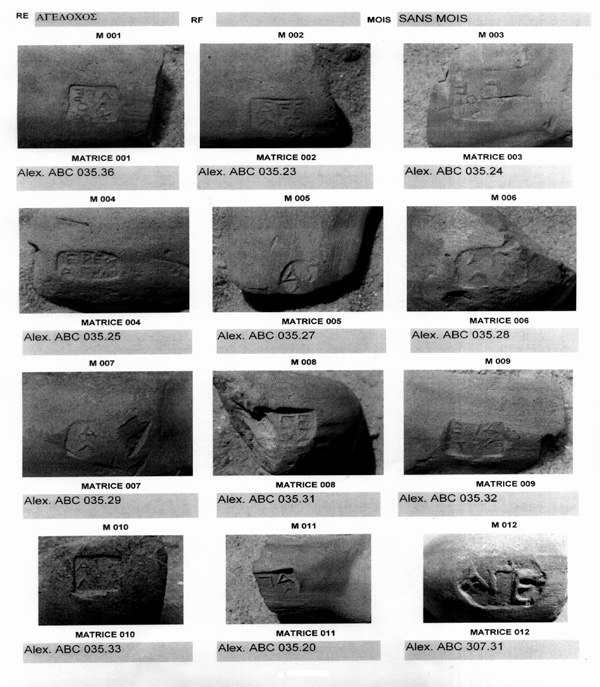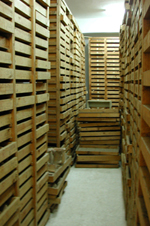
Alexandria Amphora Study Centre


CEAlex - UAR 3134
| Français | English |

| Introduction | Amphorae | Stamped Handles | Lexicon of Rhodian stamp dies | Bulletin amphorique | General Bibliography | On-line resources | Site map | Update |
Stamped amphora handles
| Methodology |
| Building the database |
| Defining the matrices |
| Lexicon of Rhodian stamps dies eponyms and fabricants |
| Chronologicals periods |
| Amphora stamps of Delos |
DEFINITION OF MATRICES
To establish the matrices of each impression, the system proposed by Jean-Yves Empereur* has been taken as a model. According to this system, all the impressions are formulated and numbered depending on the inscribed information on the stamp. This system can be considered as a kind of "open system" to every new matrix type which will be found later. V. Grace, during her studies on the matrices, gave a number to Rhodian eponyms and fabricants in alphabetical order. But any new eponym or fabricant name caused a problem when adding them into the existing list. A similar sort of difficulty occurs for Knidian stamps. The existing KT numbers are in order at the beginning in an alphabetical order according to the names of the fabricants and then the magistrates whose names are associated with the fabricants, but when new types were found, the necessity of giving a new KT number caused confusion and made finding the matrix in question difficult. For example, a newly found stamp of a fabricant whose name begins with alpha ends with a number like KT 2437. The new system proposed here permits the integration of all new matrices of any origin which will be found in the future.
The abbreviations in the matrices are used to indicate the following full words:
R: Rhodian
K: Knidian
KO: Koan
X: Chian
X-lag: Chian Lagynos
NIK: Nikandros Group
E: Eponym
F: Fabricant
D: Duoviri
Ph. Phrourarchos
TS: Timbre Secondaire (Secondary Stamp)
MC: Matrice Complementaire (Complementary Matrix)
M: Month-name
The matrices are identified according to any difference seen on the impression, such as the characteristics of the letters, the organization of the stamp depending on the division of the words (names, prepositions, titles, month-names), number of lines, devices, place of the device, form of the stamp, measurement of the stamp, inscription errors, abbreviations, space between letters or after/before words etc.
As seen above, the matrix numbers do not cause any complexity. To get more detailed information about a certain matrix, one should see the form of it in the database or in another version of the stamp database, which will be presented below, containing the best photos of every matrix belonging to eponyms or fabricants with and/or without month-names.
For our studies in Alexandria, another type of database containing only the photographs of matrices has also been prepared (fig. 7). In fact, it is a simple card system applied in the computer with Filemaker Pro 8.5. For every eponym and fabricant with different month-names and without a month-name, a form is created. In the forms, one can find the best photos or the rubbings of each matrix with the indication of the matrix number and the inventory number of the stamp. This allows the researchers to see all the matrices of a certain eponym/fabricant with a certain month-name/without a month-name together in need of comparison, identification or restoration of their impressions (or matrices).

Fig 7
